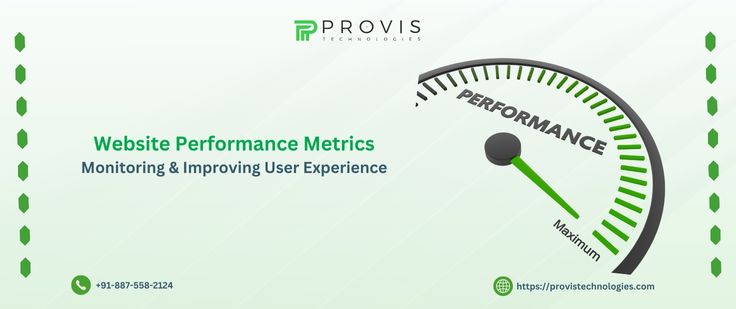Today, providing an optimal user experience on your website is crucial for success due to shorter attention spans & higher competition. If users don’t find your site attractive, fast, easy to navigate, & smooth – they won’t use it. Maintaining its performance plays an essential role in keeping these aspects fit. Let’s see some unavoidable website performance metrics every site owner must use to improve the overall user experience. You can also hire a website maintenance services company to maintain your website’s performance at its best.
The Importance of Website Performance Metrics
Page Load Time (PLT)
PLT is the duration it takes for a web page to fully load. Studies have shown that users tend to leave a website if it takes more than a few seconds to load. To enhance PLT, consider optimizing images, leveraging browser caching, and minimizing HTTP requests.
Time to First Byte (TTFB)
TTFB means the time taken for the first byte of data to arrive. It’s a crucial metric, as a slow TTFB can delay page loading. Optimize TTFB by upgrading hosting, using a Content Delivery Network (CDN), and streamlining server-side processes.
Render Start Time
Render Start Time focuses on when the first visual elements appear on the user’s screen. While PLT is essential, users perceive a page faster when they see content rendering quickly. Optimize render start time by minimizing render-blocking resources, prioritizing critical CSS & JavaScript, and optimizing the critical rendering path.
Page Size
With the rise of multimedia content, it’s easy for webpages to become heavy, leading to slower load times. Page size measures the total amount of data that needs to be downloaded to display a webpage. Compressing images, minifying CSS and JavaScript, and utilizing efficient coding practices can significantly reduce page size & improve loading speeds.
Don’t Miss:- A Step-by-Step Guide to Website Optimization Strategies for 2024
Tools for Monitoring Website Performance
To effectively enhance performance, it’s crucial to use the right tools for monitoring. Several tools provide insights into various performance metrics to help you identify the areas for improvement.
Google PageSpeed Insights
Google’s PageSpeed Insights analyzes web page performance for both desktop & mobile devices to provide actionable suggestions to improve speed & UX. It assigns a score to your website based on its performance and offers optimization recommendations.
GTmetrix
GTmetrix is a complete tool that assesses your website’s speed performance and provides detailed reports. It offers insights into page load time, page size, and other essential metrics, along with specific recommendations for improvement.
WebPageTest
WebPageTest allows you to test your website’s performance from multiple locations & browsers. It provides a waterfall chart visually representing the loading process. It also helps you identify which resources are causing delays.
Lighthouse
Lighthouse, an open-source tool by Google, audits webpages for performance, accessibility, SEO, and more. It generates a report with actionable insights to optimize your website. Lighthouse is available as a browser extension and through the Chrome DevTools.
Must Know:- Future Proofing with PHP – Why is Regular Maintenance Essential?
Strategies for Improving Website Performance
Armed with insights from performance monitoring tools, here are strategies to enhance website performance and deliver an exceptional user experience.
Optimize Multimedia Content
Images & multimedia elements often contribute to a significant portion of a webpage’s size. Compress images without compromising quality, use responsive images, and employ lazy loading to ensure these elements are loaded when they come into the user’s viewport.
Minimize HTTP Requests
Each element on a webpage, such as images, scripts, and stylesheets – requires an HTTP request to be loaded. Minimize the number of requests by combining files, using CSS sprites, and optimizing script loading. This decreases latency & speeds up page loading.
Utilize Browser Caching
Browser caching allows frequently accessed resources to be stored locally on a user’s device – reducing the need to download them on each visit. Set appropriate expiration dates for resources to ensure users receive the latest content when necessary.
Implement Content Delivery Networks (CDNs)
CDN is the distribution of the site’s static content to the servers globally. This reduces server load and improves the proximity of content delivery to users – resulting in faster load times. Consider integrating a CDN to optimize global performance.
Prioritize Critical Rendering Path
Optimize the critical rendering path by prioritizing the loading of essential resources. This involves minimizing render-blocking resources, optimizing CSS delivery, and deferring non-essential JavaScript. By streamlining the rendering process, you enhance the perceived speed of your website.
Regularly Monitor & Test Performance
Website performance is not a one-time effort but an ongoing process. Regularly monitor your site’s performance using tools like PageSpeed Insights, GTmetrix, and more. Conduct performance tests to identify new issues and ensure that optimizations continue to deliver a seamless user experience. Or connect with a website maintenance services company to take care of your site.
Related Blog:- Best Maintenance Tips for WordPress Online Stores
Conclusion
Monitoring & improving website performance metrics help provide users a delightful online experience. By understanding key metrics, utilizing performance monitoring tools, and implementing optimization strategies – businesses can create fast, responsive, and engaging websites that captivate users and drive success in the digital space.
FAQs
Question – What does it mean – Website Performance Metrics?
Answer – Website Performance Metrics is the technical analysis of a website’s performance using various analytical tools. Analysis in terms of site’s speed, SEO, and more.
Question – Why is it necessary?
Answer – It is necessary to maintain and drive results from a website. If a site is not maintained, it is of no use.
Question – Are there any agencies that do this for my site?
Answer – Yes! Website maintenance agencies like Provis Technologies handle your site for you, providing A to Z top-class maintenance & development solutions.
Question – How much does it cost?
Answer – Cost is not fixed as each project is unique; however, you can provide website maintenance services from companies like Provis Technologies and get a free IT consultation, plan, and an unbeatable quote.
Written By
Author's Picks
- All You Need to Know About Website Downtime & Ways to Prevent It
- 03/02/2024
- How to Perform a Website Health Check – A Step-by-Step Guide
- 18/12/2023
- Issues You Might be Facing with Wix at this point of your Business | Scalability Issues in Wix
- 21/09/2024
Categories
- AI for Startups
- AI in Web Development
- AI Integration
- AI Platforms
- AI Prompt
- AI Tools
- AI Trading Software
- Android App
- Android vs iOS Development
- Angular
- API
- API Development
- App
- app development
- App Idea
- App User Feedback
- Application
- Artificial Intelligence
- Audit Services
- Automotive Industry
- Awards and Recognition
- Business Consulting
- Business Website
- Chatbots
- CRM
- CRM for Financial Advisors
- Custom CRM
- Custom SaaS
- Custom Website
- Customer Service
- dashboard design
- Developing a Mobile App
- Digital Business
- E-commerce
- EMR Integration
- Finance
- Financial Advisors
- Financial Advisors
- GIT
- Health Insurance
- iOS App
- iOS App Development
- IoT Mobile App Development
- IoT Platforms
- IT Audit Services
- IT Consulting
- IT Strategies
- Java Development
- Laravel
- Lean Canvas
- Learning Management System
- Logistics Apps
- Mobile App Development
- MVP
- Native App
- News Aggregator Site
- OTT
- Outsourcing IT
- Payment Gateway
- predictive analysis
- Product Launch Strategy
- Progressive Web App (PWA)
- Prototype
- Recommender Systems
- Ruby
- SaaS
- SaaS Application
- SaaS Business
- SaaS Company
- SaaS Development
- SaaS Product
- SaaS Project
- Sales Funnel
- SEO
- Shopping Cart
- Software Development
- SSL and TLS
- Startup Checklist
- Technology
- Tetradic Color Scheme
- UI/UX Design Company
- Unit Testing
- User Flow
- User Testing
- Web Development
- Web Performance Optimization
- website Maintenance Services
- Website Migration Service
- Website Speed Optimization
- WooCommerce
- WordPress





